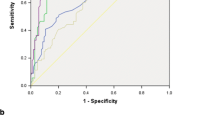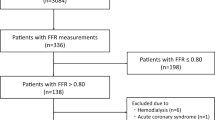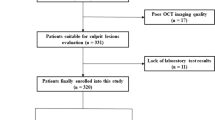Abstract
Vulnerable plaque disruption was suggested as a primary cause of acute coronary syndrome. This study investigated the impact of malondialdehyde-modified low-density lipoprotein (MDA-LDL) on whole coronary plaque vulnerability, based on multislice-computed tomography (MSCT). We included 197 patients that were not receiving lipid-lowering therapy. We retrospectively analyzed MSCT and MDA-LDL measurements. We defined a CT-derived vulnerable plaque as a plaque with a remodeling index > 1.10 and a mean CT density value < 30 HU. Vulnerable plaques were detected in 60 patients (30%). Patients with vulnerable plaques had significantly higher MDA-LDL levels than patients without vulnerable plaques (151.3 ± 42.3 vs. 118.5 ± 41.7 U/L, p < 0.01). A univariate regression analysis showed that vulnerable plaques were significantly related to MDA-LDL levels [10 U/L groups, odds ratio (OR): 1.19; p < 0.01] and in a multivariate model (10 U/L groups, OR: 1.18; p < 0.01). Patients with multivessel vulnerable plaques had significantly higher MDA-LDL levels than those with single-vessel involvement or no vulnerable plaque (172.4 ± 28.5 vs. 142.8 ± 44.2 vs. 118.5 ± 41.7 U/L, respectively; p < 0.01). MDA-LDL difference was observed for all LDL tertiles (bottom; 128.9 ± 41.1 vs. 97.3 ± 25.0 U/L, p < 0.01, middle; 142.6 ± 42.7 vs. 122.5 ± 35.1 U/L, p = 0.05, top; 166.0 ± 38.1 vs. 143.5 ± 51.6 U/L, p = 0.05). Increased MDA-LDL levels were associated with the presence and extent of vulnerable plaques, regardless of LDL levels.


Similar content being viewed by others
References
Witztum JL (1994) The oxidation hypothesis of atherosclerosis. Lancet 344:793–795
Steinberg D, Lewis A (1997) Conner memorial lecture. oxidative modification of LDL and atherogenesis. Circulation 95:1062–1071
Amaki T, Suzuki T, Nakamura F, Hayashi D, Imai Y, Morita H, Fukino K, Nojiri T, Kitano S, Hibi N, Yamazaki T, Nagai R (2004) Circulating malondialdehyde modified LDL is a biochemical risk marker for coronary artery disease. Heart 90:1211–1213
Ito T, Fujita H, Tani T, Sugiura T, Ohte N (2015) Increased circulating malondialdehyde-modified low-density lipoprotein levels in patients with ergonovine-induced coronary artery spasm. Int J Cardiol 184:475–480
Ito T, Fujita H, Tani T, Ohte N (2015) Malondialdehyde-modified low-density lipoprotein is a predictor of cardiac events in patients with stable angina on lipid-lowering therapy after percutaneous coronary intervention using drug-eluting stent. Atherosclerosis 239:311–317
Holvoet P, Collen D, Van de Werf F (1999) Malondialdehyde-modified LDL as a marker of acute coronary syndromes. JAMA 281:1718–1721
Matsuo Y, Kubo T, Okumoto Y, Ishibashi K, Komukai K, Tanimoto T, Ino Y, Kitabata H, Hirata K, Imanishi T, Akagi H, Akasaka T (2013) Circulating malondialdehyde-modified low-density lipoprotein levels are associated with the presence of thin-cap fibroatheromas determined by optical coherence tomography in coronary artery disease. Eur Heart J Cardiovasc Imaging 14:43–50
Tajika K, Okamatsu K, Takano M, Inami S, Yamamoto M, Murakami D, Kobayashi N, Ohba T, Hata N, Seino Y, Mizuno K (2012) Malondialdehyde-modified low-density lipoprotein is a useful marker to identify patients with vulnerable plaque. Circ J 76:2211–2217
Ikenaga H, Kurisu S, Kono S, Sumimoto Y, Watanabe N, Shimonaga T, Higaki T, Iwasaki T, Mitsuba N, Ishibashi K, Dohi Y, Fukuda Y, Kihara Y (2016) Impact of malondialdehyde-modified low-density lipoprotein on tissue characteristics in patients with stable coronary artery disease—integrated backscatter-intravascular ultrasound study. Circ J 80:2173–2182
Hoffmann U, Moselewski F, Cury RC, Ferencik M, Jang IK, Diaz LJ, Abbara S, Brady TJ, Achenbach S (2004) Predictive value of 16-slice multidetector spiral computed tomography to detect significant obstructive coronary artery disease in patients at high risk for coronary artery disease: patient-versus segment-based analysis. Circulation 110:2638–2643
Ito T, Terashima M, Kaneda H, Nasu K, Matsuo H, Ehara M, Kinoshita Y, Kimura M, Tanaka N, Habara M, Katoh O, Suzuki T (2011) Comparison of in vivo assessment of vulnerable plaque by 64-slice multislice computed tomography versus optical coherence tomography. Am J Cardiol 107:1270–1277
Kotani K, Maekawa M, Kanno T, Kondo A, Toda N, Manabe M (1994) Distribution of immunoreactive malondialdehyde-modified low-density lipoprotein in human serum. Biochim Biophys Acta 1215:121–125
Agatston AS, Janowitz WR, Hildner FJ, Zusmer NR, Viamonte M Jr, Detrano R (1990) Quantification of coronary artery calcium using ultrafast computed tomography. J Am Coll Cardiol 15:827–832
Motoyama S, Sarai M, Harigaya H, Anno H, Inoue K, Hara T, Naruse H, Ishii J, Hishida H, Wong ND, Virmani R, Kondo T, Ozaki Y, Narula J (2009) Computed tomographic angiography characteristics of atherosclerotic plaques subsequently resulting in acute coronary syndrome. J Am Coll Cardiol 54:49–57
Kubo T, Imanishi T, Takarada S, Kuroi A, Ueno S, Yamano T, Tanimoto T, Matsuo Y, Masho T, Kitabata H, Tsuda K, Tomobuchi Y, Akasaka T (2007) Assessment of culprit lesion morphology in acute myocardial infarction: ability of optical coherence tomography compared with intravascular ultrasound and coronary angioscopy. J Am Coll Cardiol 50:933–939
Takahashi S, Kawasaki M, Miyata S, Suzuki K, Yamaura M, Ido T, Aoyama T, Fujiwara H, Minatoguchi S (2016) Feasibility of tissue characterization of coronary plaques using 320-detector row computed tomography: comparison with integrated backscatter intravascular ultrasound. Heart Vessels 31:29–37
Chu L, Hao H, Luo M, Huang Y, Chen Z, Lu T, Zhao X, Verfaillie CM, Zweier JL, Liu Z (2011) Ox-LDL modifies the behaviour of bone marrow stem cells and impairs their endothelial differentiation via inhibition of Akt phosphorylation. J Cell Mol Med 15:423–432
Rauscher FM, Goldschmidt-Clermont PJ, Davis BH, Wang T, Gregg D, Ramaswami P, Pippen AM, Annex BH, Dong C, Taylor DA (2003) Aging, progenitor cell exhaustion, and atherosclerosis. Circulation 108:457–463
Shah PK, Falk E, Badimon JJ, Fernandez-Ortiz A, Mailhac A, Villareal-Levy G, Fallon JT, Regnstrom J, Fuster V (1995) Human monocyte-derived macrophages induce collagen breakdown in fibrous caps of atherosclerotic plaques. Potential role of matrix-degrading metalloproteinases and implications for plaque rupture. Circulation 92:1565–1569
Xu XP, Meisel SR, Ong JM, Kaul S, Cercek B, Rajavashisth TB, Sharifi B, Shah PK (1999) Oxidized low-density lipoprotein regulates matrix metalloproteinase-9 and its tissue inhibitor in human monocyte-derived macrophages. Circulation 99:993–998
Nishi K, Itabe H, Uno M, Kitazato KT, Horiguchi H, Shinno K, Nagahiro S (2002) Oxidized LDL in carotid plaques and plasma associates with plaque instability. Arterioscler Thromb Vasc Biol 22:1649–1654
Uno M, Kitazato KT, Suzue A, Itabe H, Hao L, Nagahiro S (2005) Contribution of an imbalance between oxidant-antioxidant systems to plaque vulnerability in patients with carotid artery stenosis. J Neurosurg 103:518–525
Stone NJ, Robinson JG, Lichtenstein AH, Bairey Merz CN, Blum CB, Eckel RH, Goldberg AC, Gordon D, Levy D, Lloyd-Jones DM, McBride P, Schwartz JS, Shero ST, Smith SC Jr, Watson K, Wilson PW, American College of Cardiology/American Heart Association Task Force on Practice Guidelines (2014) 2013 ACC/AHA guideline on the treatment of blood cholesterol to reduce atherosclerotic cardiovascular risk in adults: a report of the American College of Cardiology/American Heart Association Task Force on Practice Guidelines. J Am Coll Cardiol 63:2889–2934
Catapano AL, Graham I, De Backer G, Wiklund O, Chapman MJ, Drexel H, Hoes AW, Jennings CS, Landmesser U, Pedersen TR, Reiner Ž, Riccardi G, Taskinen MR, Tokgozoglu L, Verschuren WM, Vlachopoulos C, Wood DA, Zamorano JL, Authors/Task Force Members; Additional Contributor (2016) 2016 ESC/EAS guidelines for the management of dyslipidaemias. Eur Heart J 37:2999–3058
Sachdeva A, Cannon CP, Deedwania PC, Labresh KA, Smith SC Jr, Dai D, Hernandez A, Fonarow GC (2009) Lipid levels in patients hospitalized with coronary artery disease: an analysis of 136,905 hospitalizations in Get With The Guidelines. Am Heart J 157:111–117
Komukai K, Kubo T, Kitabata H, Matsuo Y, Ozaki Y, Takarada S, Okumoto Y, Shiono Y, Orii M, Shimamura K, Ueno S, Yamano T, Tanimoto T, Ino Y, Yamaguchi T, Kumiko H, Tanaka A, Imanishi T, Akagi H, Akasaka T (2014) Effect of atorvastatin therapy on fibrous cap thickness in coronary atherosclerotic plaque as assessed by optical coherence tomography: the EASY-FIT study. J Am Coll Cardiol 64:2207–2217
Author information
Authors and Affiliations
Corresponding author
Ethics declarations
Conflict of interest
The authors declare that they have no conflict of interest.
Ethical approval
All procedures performed in studies involving human participants were in accordance with the ethical standards of the institutional and/or national research committee and with the 1964 Helsinki declaration and its later amendments or comparable ethical standards. For this type of study, formal consent is not required.
Rights and permissions
About this article
Cite this article
Ito, T., Ichihashi, T., Fujita, H. et al. Impact of malondialdehyde-modified low-density lipoprotein on coronary plaque vulnerability in patients not receiving lipid-lowering therapy: a whole coronary analysis with multislice-computed tomography. Heart Vessels 33, 351–357 (2018). https://doi.org/10.1007/s00380-017-1074-4
Received:
Accepted:
Published:
Issue Date:
DOI: https://doi.org/10.1007/s00380-017-1074-4




